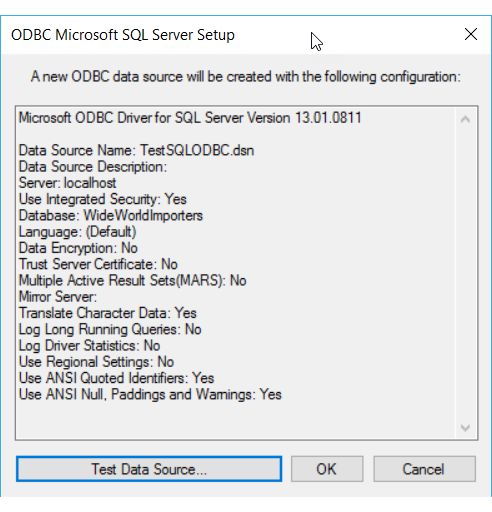
- #Test sql server connection string install#
- #Test sql server connection string drivers#
- #Test sql server connection string driver#
- #Test sql server connection string software#
- #Test sql server connection string password#
When connecting to a SQL Server Express database, you must include the instance name along with the server name. StConnect = "Provider=SQLNCLI10 Data Source=" & stServer & " Initial Catalog=" & stDatabase & " Integrated Security=SSPI " StConnect = "Provider=SQLOLEDB Data Source=" & stServer & " Initial Catalog=" & stDatabase & " Integrated Security=SSPI " You should bypass the ODBC layer altogether when connecting to SQL Sever by using a connection string similar to this one in your code: StConnect = "ODBC DRIVER=SQL Server Native Client 10.0 SERVER=" & stServer & " DATABASE=" & stDatabase & " UID=" & stUsername & " PWD=" & stPassword

Here is an example using SQL Server Native Client 10.0: StConnect = "ODBC DRIVER=SQL Server SERVER=" & stServer & " DATABASE=" & stDatabase & " UID=" & stUsername & " PWD=" & stPassword StConnect = "ODBC DRIVER=SQL Server SERVER=" & stServer & " DATABASE=" & stDatabase & _ " Trusted_Connection=Yes"Īnd here’s one using SQL Server security: Here is an example of Integrated Security with the Windows standard SQL server driver:
#Test sql server connection string password#
If you go this route you will need to pass along the user name and password in order to validate your connection. It’s the only method available if the SQL Server is on the Internet and your users are connecting from the road. The other connection method is using SQL Server security. It allows you to leverage domain credentials and security to easily manage user rights in your application. Integrated security means you are using the user’s windows credentials when connecting with SQL and is the preferred method in connecting.
#Test sql server connection string drivers#
When creating DSNless or connecting with ADODB to SQL, you have four options: Old vs new SQL drivers and Integrated Security or SQL Server logins. This is the preferred method in connecting with SQL, there is no need to create a DSN on each machine, thus avoiding all the hassles in visiting each machine when you’re ready to roll out the database.

#Test sql server connection string install#
If you decide to use SQL Server Native client you will also need to install it on the local machine when installing your solution.
#Test sql server connection string driver#
If you installed SQL Server Native Client then you will see both the old SQL Server driver and the new one as an option when creating the DSN. You can also distribute a DSN file with your application as well. This is also the least recommended, since you have to repeat the process for every computer using your Access with SQL database. The easiest way to connect with SQL would be creating a DSN on the local machine and use it to link SQL tables in Access. Make sure you pick the version compatible with your operating system. You can download the client here, just navigate to the section called “ Microsoft SQL Server 2008 Native Client”. The latter is recommended since I’ve personally seen better speeds connecting with SQL using it. You have two sets of drivers available when connecting: use the standard driver that ships with every Windows station and SQL Server Native Client. Today I’m going to talk about the different methods and connection strings you can use to connect between Access and SQL Server. Readers of my blog know how passionate I am connecting Access to SQL Server, it’s one of my favorite ways to deploy my solutions.

#Test sql server connection string software#

Labor Union Dues and Membership Management System.Insurance Claim System to Reduce Processing Time.Elected Officials Database with Ethics Form tracking.Custom Quoting and Proposal Sales Force Solution.Amazon API Integration with Microsoft Access.Convert ADP file to ACCDB (regular Access file).Enable Microsoft Access to work from home.Microsoft Access Database Inconsistent State Error.


 0 kommentar(er)
0 kommentar(er)
